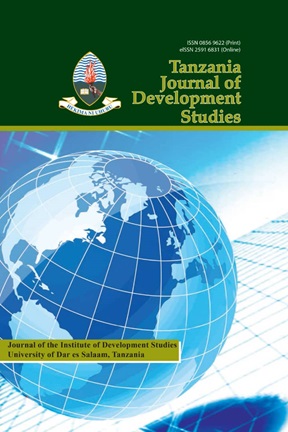Fishing for a Future: Local Institutions, Aspirations and Agency in a Complex Climate Adaptation System
Abstract
Abstract This study of two dryland fishing villages in northern Tanzania focuses on observed climate change adaptations, including market exchange, livelihood diversification, and mobility and their mediation by institutions and institutional interactions at various scales. We draw on the adaptation, institutions and livelihood (AIL) framework to highlight the key roles of local formal institutions in shaping adaptive strategies. Core contentions of political ecology inform our assessment of the origins and limitations of contemporary institutional configurations. Our household survey data suggests high levels of mobility and the potential that livelihoods are transitioning toward a persistent mode of flexible, multi-site and temporally variable livelihood engagements. The results point to the need for a closer alignment of national policy with the daily struggles of rural dwellers, and the devolution of more discretionary finance to district governments.References
References
Agrawal, A. 2008. The Role of Local Institutions in Adaptation to Climate Change. World
Bank, Washington, DC.: World Bank. https://openknowledge.worldbank.org/
handle/10986/28274.
Agrawal, A. 2009. Local Institutions and Adaptation to Climate Change. In R. Mearns &
A. Norton (Eds.), Social Dimensions of Climate Change: Equity and Vulnerability in a
Warming World (pp. 173 €“198). World Bank: Washington DC.
Agrawal, A. & N. Perrin. (2008). Climate Adaptation, Local Institutions, and Rural Livelihoods.
IFRI Working Paper# W08I-6, International Forestry Resources and Institutions
Program. Ann Arbor: University of Michigan. doi: http://www.umich.edu/~ifri/
publications/w08i6%20arun%20agrawal%20and%20nicolas%20perrin.pdf.
Badjeck, M.-C., E. H. Allison, A. S. Halls & N. K. Dulvy. (2010). Impacts of Climate
Variability and Change on Fishery-Based Livelihoods. Marine Policy, 34(3): 375 €“383.
Basurto, X., A. Bennett, A. H. Weaver, S. Rodriguez-Van Dyck, €¦ & J.-S. Aceves-Bueno.
(2013). Cooperative and Noncooperative Strategies for Small-Scale Fisheries ' SelfGovernance in the Globalization Era: Implications for Conservation. Ecology and Society
(4): 38, http://dx.doi.org/10.5751/es-05673-180438.
Boone, C. (2003). Decentralization as Political Strategy in West Africa. Comparative Political
Studies, 36(4): 355 €“380. https://doi.org/10.1177/0010414003251173.
Bryceson, D. (2015). Reflections on the Unravelling of the Tanzanian Peasantry, 1975 €“
In Looking Back, Looking Ahead: Land, Agriculture and Society in East Africa.
Nordiskaafrikainstitutet.
Bryceson, D. F. (2002). Multiplex Livelihoods in Rural Africa: Recasting the Terms and
Conditions of Gainful Employment. Journal of Modern African Studies, 40(1): 1 €“28.
https://doi.org/10.1017/s0022278x01003792.
Bryceson, D. F., Bradbury, A. & Bradbury, T. (2008). Roads to Poverty Reduction?
Exploring Rural Roads ' Impact on Mobility in Africa and Asia. Development Policy
Review, 26(4): 459 €“482.
Conte, C. A. (1995). Nature Reorganized: Ecological History in the Plateau Forests of the
West Usambara Mountains, C. 1850-1935. In Custodians of the Land: Ecology and Culture
in the History of Tanzania (pp. 96 €“122). James Currey and Ohio University Press.
Coulthard, S. (2008). Adapting to Environmental Change in Artisanal Fisheries €”Insights
from a South Indian Lagoon. Global Environmental Change, 18(3): 479 €“489.
Dalisay, S. (2019). The Role of ICH in Disaster Memory. Proceedings of the Asia-Pacific
Workshop on Intangible Cultural Memory in Natural Disaster, 38-41.
Dasgupta, P., J. F. Morton, D. Dodman, B. Karapınar, F. Meza, M. G. Rivera-Ferre &
A.T. (2014). Rural Areas. In C. B. Field et al. (eds.). Climate Change 2014: Impacts,
Adaptation, and Vulnerability. Part A: Global and Sectoral Aspects. Contribution of Working
Group II to the Fifth Assessment Report of the Intergovernmental Panel on Climate Change (pp.
€“657). Cambridge University Press.
De Graaf, G. & L. Garibaldi. (2014). The Value of African Fisheries. FAO Fisheries and
Aquaculture Circular. No. 1093. Rome: FAO.
Denny, P. (1978). Nyumba ya Mungu Reservoir, Tanzania: The General Features.
Biological Journal of the Linnean Society, 10(1): 5 €“28.
Ellis, F. (1998). Household Strategies and Rural Livelihood Diversification. Journal of
Development Studies, 35(1): 1 €“38.
Ellis, F. (2000). The Determinants of Rural Livelihood Diversification in Developing
Countries. Journal of Agricultural Economics, 51(2): 289 €“302.
Fjeldstad, O.-H., M. Ali & L. Katera. (2018). Policy Implementation Under Stress: CentralLocal Government Relations in Property Tax Collection in Tanzania. CMI Working
Paper No. 1, Osla: Chr. Michelsen Institute.
Folke, C., T. Hahn, P. Olsson & J. Norberg. (2005). Adaptive Governance of SocialEcological Systems. Annual. Review of Environmental Resources, 30: 441 €“473.
Forde, C. D. (1934). Habitat, Economy, and Society: A Geographical Introduction to Ethnology.
Methuen.
Geheb, K. & T. Binns. (1997). "Fishing Farmers ' ' or "Farming Fishermen ' ' ? the Quest for
Household Income and Nutritional Security on the Kenyan Shores of Lake Victoria." '
African Affairs, 96(382): 73 €“93.
Goulden, M. C., W. N. Adger, E. H. Allison & D. Conway. (2013). Limits to Resilience
from Livelihood Diversification and Social Capital in Lake Social €“Ecological Systems.
Annals of the Association of American Geographers, 103(4): 906 €“924.
Harrison, E. & A. Mdee. (2017). Successful Small-Scale Irrigation or Environmental
Destruction? the Political Ecology of Competing Claims on Water in the Uluguru
Mountains, Tanzania. Journal of Political Ecology, 24: 406 €“424.
Heck, S., C. Béné & R. Reyes-Gaskin. (2007). Investing in African Fisheries: Building Links
to the Millennium Development Goals. Fish and Fisheries, 8(3): 211 €“226.
Jentoft, S. & A. Eide, Eds. (2011). Poverty Mosaics: Realities and Prospects in Small-Scale
Fisheries. Springer Science & Business Media.
Kolding, J., P. Van Zwieten, F. Marttin & F. Poulain. (2016). Fisheries in the Drylands of
Sub-Saharan Africa "Fish Come With the Rains." FAO Fisheries and Aquaculture Circular,
C1118.
Lange, S. (2008). The Depoliticisation of Development and the Democratisation of Politics
in Tanzania: Parallel Structures as Obstacles to Delivering Services to the Poor. The
Journal of Development Studies, 44(8): 1122 €“1144.
Le Blanc, A. (2012). Remembering Disasters: The Resilience Approach. Journal of Art
History and Practice, 13: 217 €“245.
Lind, J. (2018). Devolution, Shifting Centre-Periphery Relationships and Conflict in
Northern Kenya. Political Geography, 63: 135 €“147. https://doi.org/10.1016/ j.polgeo.
06.004.
Maldonado, J. K. (2014). A Multiple Knowledge Approach for Adaptation to
Environmental Change: Lessons Learned from Coastal Louisiana ' s Tribal
Communities. Journal of Political Ecology, 21(1): 61 €“82.


